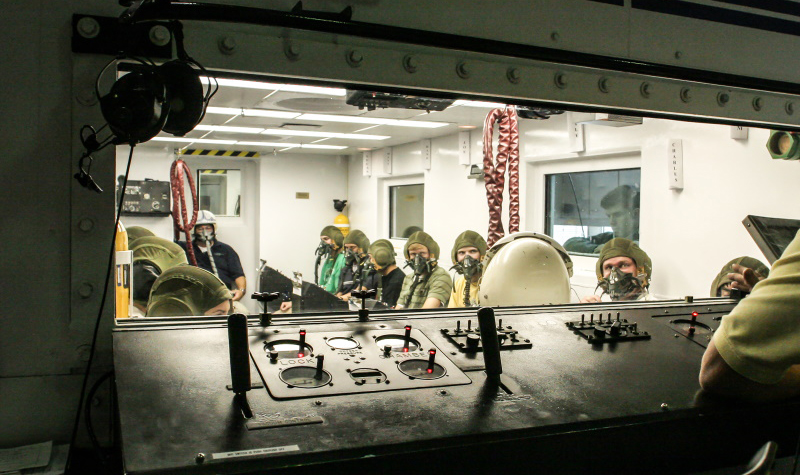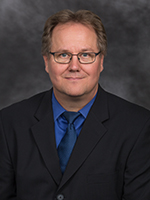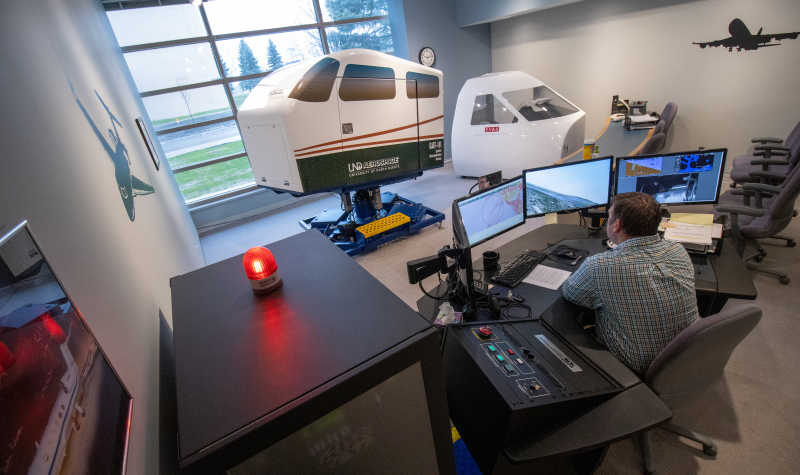At UND Aerospace, a training experience with few equals
Clearing 500-course milestone, flight physiologists at UND Aerospace continue life-saving training for students and companies alike

Outside of the military, it’s nearly impossible to experience high-altitude conditions on the ground. Ditto with what it’s like to suffer from complete visual and physical disorientation from the safety of a simulation.
But at UND, such training is a standard for every student studying aviation. Since 1990, UND Aerospace has been home to one of the few altitude chambers operated by a university, and the program’s other specialized flight training devices put UND in rarer company still.
With access to these training environments, students enrolled in their mandatory flight physiology course are able to better understand and respond to the warning signs of depressurization, hypoxia (oxygen deprivation) and spatial disorientation that can befall any pilot, depending on the circumstances.

And for the past 30 years, UND has also played host to Fortune 500 companies and a variety of organizations and flight schools looking for that very same training – albeit in a condensed format, as opposed to a semester-long course.
In recent weeks, the flight physiology department at UND Aerospace completed its 500th corporate course, as they’re known. These courses deliver UND’s altitude training in a two-day session.
More than 3,000 people have attended, in addition to the more than 9,000 who went through similar training as UND students.
And from the feedback that Director of Flight Physiology Tom Zeidlik receives, UND has been able to offer an experience found in few other places that are accessible by civilians.
“In our corporate classes we have people who have been flying for 20 to 30 years, and they’re flying some of the highest-tier business jets and transport aircraft,” Ziedlik said. “A majority of them write, ‘I wish I would have known this stuff years ago. I wish I would have taken this class a long time ago.’
“Even super-experienced pilots are finding a lot of value in this class.”

Lessons you can feel
Found on the ground floor of Odegard Hall, the gray, hulking altitude chamber with porthole windows is “military grade” in every sense of the term. People seated inside the chamber are able to feel the precise effects of rapid decompression – the sudden depressurization of an enclosed space, such as an airplane cabin – as well as the lack of air when such an event occurs.

Zeidlik credits Steven Martin, a military-trained aerospace physiologist and the manager of the department, with keeping such a unique technology operating as smoothly as it does.
“Teaching pilots in this way has been a military and practical discipline for decades, but, in the civilian world, it’s relatively unknown,” Martin said. “Even though it’s not a widely available type of training for most pilots, I would say the skills are necessary to learn.”
Over the two days of the typical corporate course delivery, Martin spends the first day going over high altitude physiology, meaning how the atmosphere influences human performance. The second day brings lessons on sensory physiology, or human orientation systems and different types of disorientation.
In his words, people can read about the symptoms of hypoxia, or memorize what illusions can cause disorientation while flying. But at UND, those things are felt, not imagined, and experienced as realistically as possible on the ground.
“It’s possible to put students in a tent and pump in nitrogen, which can cause hypoxia, but they don’t feel their ears pop, or feel the gas expansion and pressure change,” Zeidlik said. “Here, we can do a rapid decompression where we go through a 4.4 PSI pressure change, and you end up with the longest exhale you’re ever going to have in your life. There isn’t another school where you experience that.”
Military training philosophy for professionals
In addition to the altitude chamber, UND Aerospace boasts an impressive fleet of ground-based flight trainers, including a spatial disorientation trainer used by the flight physiology team. The enclosed cockpit replica forces pilots into no-visibility scenarios, for instance, while also using a wide range of motion to cause a realistic distortion between what is seen and felt.
“I’ve flown airplanes almost all my life, and what you feel in there is real,” Zeidlik said. “When I get in, I always laugh and say I don’t know whether I’m on foot or horseback.”
But spatial disorientation, the marriage between visual and sensory illusions during flight, is no joke. Such impairment causes crashes across the world every year. It caused the death of NBA legend Kobe Bryant in early 2020, Zeidlik said, which led to a surge of corporate pilots seeking specialized training at places such as UND.
“Just to give one example, oxygen equipment is something that civilian pilots don’t have a lot of opportunity to work with,” Martin said. “It’s always there in the cockpit, but a lot of professional pilots are kind of afraid of the oxygen masks, whether because of inexperience or misinformation. We wanted to incorporate the military training philosophy into professional pilot training.”
Zeidlik agreed. “At 25,000 feet, the FAA says you have three to five minutes of useful consciousness, where you can still help yourself,” he said. “In our experience, which is 9,000 students, we rarely have anybody off oxygen for more than three minutes.
“Actually feeling the real thing is vastly different from anything you can read.”

‘Tip of the spear’ for safety
Because of that, UND has been able to develop close relationships with the likes of Raytheon, Phillip Morris International, Abbott Labs, Merck and other large companies that employ multiple aircraft to shuttle executives and conduct global business. Martin said the training at UND is recommended by the Federal Aviation Administration, the National Business Aviation Administration and the International Business Aviation Council.
In addition to the 150 companies that have worked with UND to receive the two-day flight physiology training, multiple federal agencies such as the Drug Enforcement Agency and Customs and Border Protection as well as schools such as Mankato State University and South Dakota State University have made trips to UND for the chance to use what would otherwise be cost-prohibitive equipment.
Recently, the team established a new webpage – aerospacephysiology.com – with information about corporate course pricing and availability, the training facilities used as well as the team members involved.
And next summer, UND is expected to install another spatial disorientation trainer, but the new unit will be fitted for helicopter pilot training. According to Zeidlik, the only other two trainers of this kind are located at the U.S. Army’s Fort Rucker, in Alabama. UND Aerospace made the announcement of the acquisition this past month.
Given how the fixed-wing trainers are already hard to come by, this form of helicopter training is as “tip of the spear” as safety training can be, said Martin.
According to Associate Dean Elizabeth Bjerke, UND Aerospace is in a unique position to provide valuable training to the College’s industry partners.
“This type of training goes well above the minimum required by the FAA, and has been proven to save lives and reduce accidents,” Bjerke said. “It is also great exposure for the University of North Dakota as it gives individuals a reason to visit our beautiful campus! We are looking forward to expanding our physiology offerings for both our students and corporate clients.”



